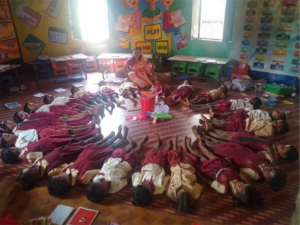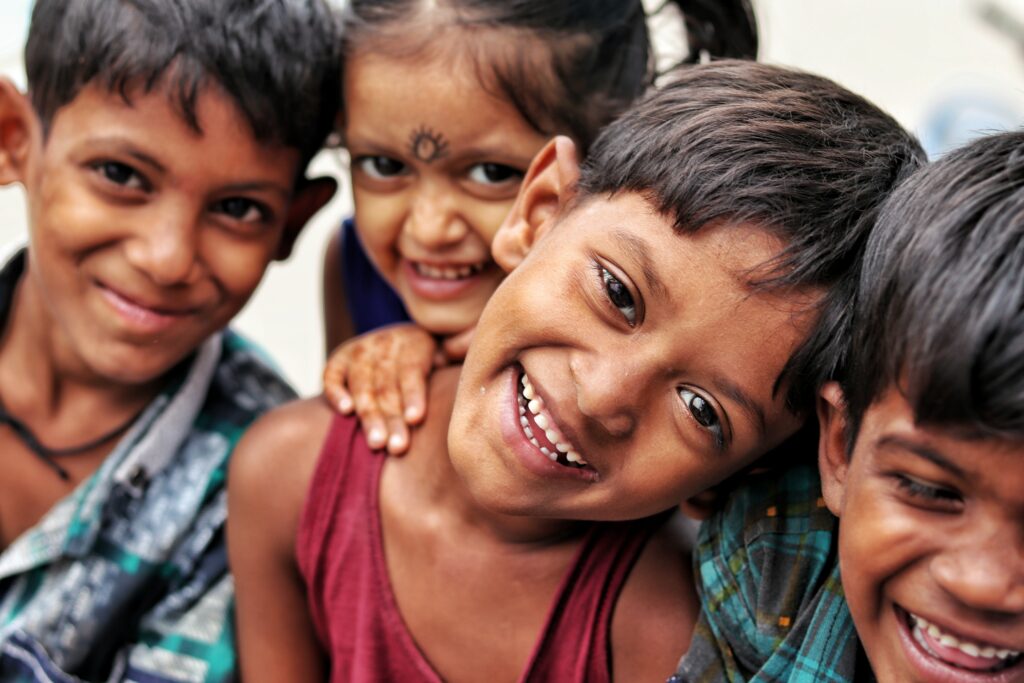Touted as the “hockey district of Jharkhand”, Simdega is a picturesque tribal district in southwestern Jharkhand. Home to seasoned players like Salima Tete and Sangita Kumari, it was only a couple of years back that Simdega got its first AstroTurf hockey pitch. This lack of access to better amenities can be seen in other sectors as well. Development is still in its nascent stage in this sleepy town district. Dense forests and undulating terrain in Simdega have resulted in the population getting scattered across the district with more than half the district falling under shadow areas with little or no access to network coverage. The resulting deprivation and unemployment provided a conducive environment for left wing extremism (LWE) and human trafficking to grow at an alarming pace, plaguing Simdega for years. Not long ago, grim stories of helpless parents forcibly sending their adolescent children to far off places for fear of losing them to extremists or of little girls being sold off for barely1000 INR were common occurrence in Simdega.
However, the blend of government programmes and the concerted efforts of the district administration has helped craft a new success story for Simdega – a story of sheer determination of the administration and stalwart support of the masses. Despite being crippled by a serious human resource and infrastructure crunch, the district has made commendable progress in the five thematic sectors of NITI Aayog’s Aspirational Districts Programme (ADP). From being one of the ‘least improved districts’ at the outset of the Delta Ranking of the Aspirational Districts, in May 2018, Simdega displayed consistent improvement over the years and made an impressive jump to be one among the Top 10 Aspirational Districts Since Inception, as is evident from the ADP’s Champions of Change dashboard.
(https://limararuv5gr0sh-nitiprdadw.adb.ap-mumbai-1.oraclecloudapps.com/ords/f?p=100:2)
One of the first things that catches your attention in Simdega is how well the Police department is woven into the administrative fabric of the district. Being a LWE-affected district, a major challenge facing the administration is the facilitation of strong dialogue with the public. Initiatives like Janta Durbar and Khelo Simdega, flagship programmes of the Simdega Police Department, have gone a long way in building trust and bridging the gap between the Police and the Public. While the former aims to encourage seamless interaction with the Police through grievance sharing, the latter is aimed at tapping the hockey potential of the youth through regular hockey matches organized with the help of Special Central Assistance (SCA) funds.
The amount of trust that the commoners have begun to place in the Police was evident when Mamta Kumari, a class X student, told me how excited she was to go to “Police Uncle Tutorial” in the evening. Launched on Gandhi Jayanti in October 2019, Police Uncle Tutorial is a one-of-a-kind initiative that targets dropouts and academically weak students of Class X in the LWE-affected areas of the district where children are more susceptible to crime. Teachers of government schools, retired people and those willing to contribute
for the society have been roped in as resource persons for teaching the students. The zeal and passion of these “dedicated teachers”, as they are rightly called, was overwhelming.
The other major hurdle hindering Simdega’s development is an acute shortage of manpower. Sectors like education and health are most adversely affected by this human resource crunch. The smart classrooms and white boards installed in her school fail to satisfy 13 year old Jyoti Kumari who aspires to be a nurse. She yearns earnestly for a teacher whom she could approach for guidance and counselling. Most schools have an abysmal pupil-teacher ratio with numbers as low as 1 teacher for 300 students. Inadequate toilets and
crumbling infrastructure are other big concerns.
Amid these dreary findings, my visit to GMS Rajutoli, came as a breath of fresh air. Surrounded by lush green fields in the interiors of Kolebira block, the school boasts of an ideal pupil-teacher ratio of 30:1 with regular attendance and 100% transition rate between primary and upper primary stages. Creative quotes and educative paintings depicting informative facts such as Bloom’s taxonomy adorn the walls of the school. Innovative teaching methods are employed by teachers in kindergarten to strengthen the learning experience of the students who seem to be enjoying the process of learning. The process involves reading out stories to the children while they close their eyes in an attempt to sleep/meditate. To my surprise, once the teacher finished the story and asked the students to open their eyes, they answered all questions posed to them, each one competing with the other to shout out the right answer! This method of teaching, aimed at increasing the learning outcome, may be employed in other schools in the country.

Figure 1: Innovative teaching method employed at GMS Rajutoli, Kolebira, Simdega
The dearth of manpower was also evident in the health sector. Expensive equipment remained unutilized in an unused ICU in the district hospital due to absence of specialists like anaesthetists. Nevertheless, the district is on a slow but steady path to progress. For instance, full immunization coverage for children aged between 9-11 months was achieved in October 2019. The successful implementation of the VHSND program in Simdega may be credited for this tremendous achievement. Locally popularized as “Mai Chowa Jatra” (Mother and child celebration), the initiative is targeted to cater to pregnant/lactating mothers, newlywed couples and adolescents. Apart from Maternal Newborn and Child Health (MNCH) services, awareness sessions, testing for anaemia, malaria and diarrhea and timely distribution of Iron and Folic Acid (IFA) tablets are conducted at these centers. The presence of all three cadres of Community Health Workers (CHWs) – ASHA, AWA and ANM- at the same place every month holds the potential of being developed as a platform for ensuring high quality and effective MNCH service delivery and information dissemination.
It was heartening to see parents and kids pouring into the anganwadi, early in the morning. The children were gleefully playing with the toys recently procured using Government funds, while they waited for their ‘teekakaran’ (immunization). The day I visited also happened to be their “Hand Wash” day. As I watched the older children diligently wash their hands with soap and explain its importance to me, I felt reassured and happy.
The increased focus on treatment of malnutrition, anaemia and TB is encouraging. From achieving over 95% success rate in TB and anaemia treatment to reducing Severe Acute Malnourishment (SAM) to less than 5% in March 2022, the district has come a long way from the baseline figures. The District Hospital in Simdega has set up a Malnutrition Testing Centre with 10 bed capacity to provide round the clock monitoring of the dietary habits of malnourished children for a 14-day period. The district however needs to focus more on maternal health to gain progress under SDG 3 (Good Health and Well-being). Increasing the share of institutional deliveries and ensuring more pregnant women benefit from the Supplementary Nutrition under the ICDS programme need to be prioritized.
Another highlight of my visit to Simdega was my interaction with the Rani Mistrys (Female Masons). The concept of Rani Mistry, germinated during the Swachh Bharat Mission-Gramin (SBM-G) campaign in the district with an aim to meet the shortage of masons for the construction of toilets. Trained with the assistance of UNICEF, the women were soon ready to break into an otherwise male dominated profession. With the help of these gritty women masons, the district achieved the status of ODF (Open Defecation Free) district in the month of April 2018. To help them sustain their newly found livelihood, the Rani Mistrys are currently involved in the construction of houses under PMAY.
Smt.Praphulit Kujur and Smt.Grace Soren, two plucky Rani Mistrys, epitomize confidence and hope. They unanimously claim that their lives have improved for the better socially and economically after being christened “Rani Mistry”. From earning a meagre Rs.150 a day, they now earn close to Rs.400-Rs.500 daily. They feel empowered and consider themselves an equal contributor to the household needs. As I bid them farewell, they shyly shared their dream of constructing their own house one day.
In summary, my visit to Simdega was a humbling experience. While Simdega has made significant advances over the last few years, there is still a lot of ground to cover. With continued implementation of novel government schemes and wholehearted participation of all officials concerned, Simdega will soon be able to tide over the current challenges. I sincerely wish that the many good SamaritansI had the opportunity to meet in Simdega will continue with their noble cause to bring the district at par with the best in the country.


